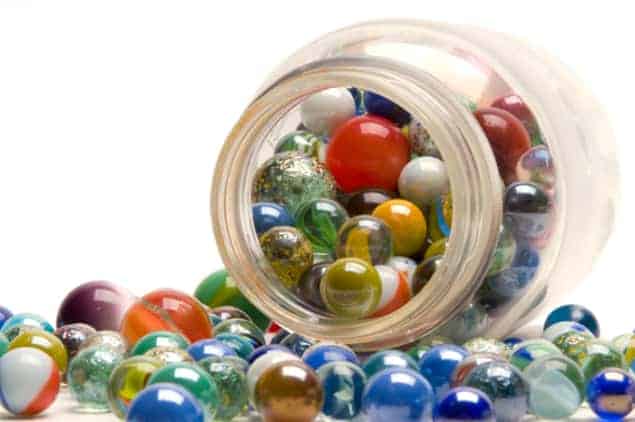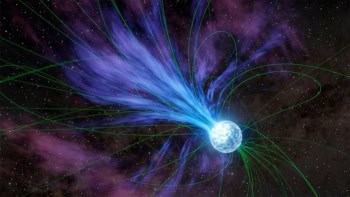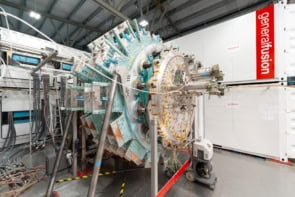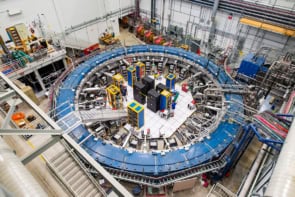
Modern cryptography combined with simple radiation detectors could allow nuclear-weapons checks to be carried out with almost complete security. That is the conclusion of scientists in the US, who have used computer simulations to show how a beam of neutrons can establish the authenticity of a nuclear warhead without revealing any information about that weapon’s composition or design.
Current arms-control arrangements between the US and Russia limit the number of nuclear warheads inside missiles. However, future agreements could require that all warheads be accounted for, including those in storage. This would rely on inspectors being able to tell a real nuclear warhead apart from a fake one – which would prevent a country from secretly stashing away some of its declared warheads.
Plutonium-239 in a concealed warhead can be revealed by exposing it to gamma rays or neutrons. However, this means of detection would also reveal secret information about the design of the weapon, which must be kept from the inspectors to prevent nuclear proliferation.
Open to abuse
Proposed schemes to avoid this problem involve passing the detector’s output through an electronic device that strips the data of their sensitive elements, such as the precise amount of radioactive material contained in the weapon. Such techniques, however, are open to abuse. The inspector could syphon off sensitive data, while the weapon’s owner could interfere with the device and make innocuous objects appear to be nuclear warheads.
The newly proposed technique closes these loopholes by not producing any sensitive information in the first place. It is based on the “zero-knowledge proof”, in which two objects can be shown with near certainty to be identical, even though nothing is known about the objects themselves. In their work, Alexander Glaser of Princeton University and colleagues adapt a game in which a character known as Alice must prove to a second person, Bob, that the number of marbles in each of two cups she is holding is the same, without revealing what that number (N) is.
Alice empties the contents of each cup into a separate bucket, each of which she says already contains 100–N marbles. Bob then counts the number of marbles in each bucket to find out whether or not they add up to 100. Alice could try to deceive Bob by not putting the same number of marbles in each bucket. However, if Bob specifies which cup must be emptied into which bucket he has a 50-50 chance of discovering Alice’s deception. If the process is repeated many times – and Alice continues to lie – it is unlikely that she can maintain her deception for long.
Arrays of neutron detectors
For weapons verification, the idea is for the host (Alice) to show the inspector (Bob) that an unknown, concealed object is identical to a known nuclear warhead. Both items are exposed to beams containing equal numbers of high-energy neutrons, with the transmitted radiation recorded by two separate arrays of simple detectors that cannot be tampered with clandestinely. Playing the role of the buckets, the detectors are set by the host to compensate precisely for the reduction in recorded intensity that the warhead in question is known to cause.
The inspector should find that all of the detectors display the same, maximum count that would be recorded if no object were to be placed in the neutron beam. However, to make sure that no cheating has taken place, the inspector chooses which detector array is assigned to which object. If the host has lied then some of the detectors will not show the maximum count – and if the process is repeated enough times, the chance of evasion is close to zero. The inspector can therefore establish whether or not the unknown object is a nuclear warhead, and does so without finding anything out about the weapon itself.
To investigate the feasibility of their technique, Glaser and colleagues carried out a Monte Carlo simulation in which neutrons with an energy of 14 MeV irradiate a 19-cm-diameter ball containing concentric rings of polystyrene, tungsten, aluminium, graphite and steel. This standard object is used to calibrate nuclear-weapon imaging systems. They found that their technique should reveal whether the tungsten had been removed or replaced by lead, even for relatively small neutron doses.
Cheating could leak information
John Finney of University College London believes that the new approach should be less vulnerable to cheating than existing techniques that rely on an information barrier. “It could potentially be a major step-change in improving confidence in inspections,” he says, “as long as you work through to prove that the system works as designed.” Another “nice twist” to the work, he adds, is that any attempt by a host to tweak pre-loaded data might actually lead to classified information leaking out. “It is an inherent property of the system that it goes against attempts to cheat,” he says.
Glaser is now looking to reproduce his group’s results experimentally, using neutrons from the Princeton Plasma Physics Laboratory and bubble chambers as detectors. One priority is ensuring the stability of the neutron source to guarantee that unknown and reference objects are exposed to equally large neutron fluxes. Also critical is establishing the consistency of the detectors. “Can we distinguish a fresh bubble from a pre-loaded bubble?” he asks. “If it turns out we can, then that is something we have to know.” These tests should yield results within about six months, and then the technique will be evaluated using real weapons materials.
The research is described in Nature.



